|
|
|
Sort Order |
|
|
|
Items / Page
|
|
|
|
|
|
|
| Srl | Item |
| 1 |
ID:
104091
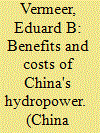

|
|
|
|
|
| Publication |
2011.
|
| Summary/Abstract |
During the past few years, the Chinese government has formulated ambitious plans for building many large hydropower stations, but so far it has withheld final approval for the construction of the majority. The environmental problems and rising cost of coal-fired stations, China's Copenhagen commitment, the creation of a high-voltage national power grid, and the availability of cheap capital should have all worked to the advantage of hydropower. Moreover, present projects require much less resettlement than those in previous decades. However, since 2006 political concern for the social problems of forced migration and distrust of the business alliance between power companies and provincial governments seem to be obstacles. Stricter regulations for environmental impact assessment, more comprehensive planning of water and reservoir use, and a lack of staff have lengthened approval processes. Central and provincial governments do not agree on developmental priorities and electricity prices. Uncertainty about obligations imposed on investing power companies is a factor too. Thus, hydropower policy suffers from conflicting goals and uneven commitment of various bureaucratic interests. Even if a clear policy commitment could improve policy implementation, China's target of 330 GW of regular hydropower capacity in 2020, and thereby its renewable energy target, are unlikely to be met.
|
|
|
|
|
|
|
|
|
|
|
|
|
|
|
|
| 2 |
ID:
120209
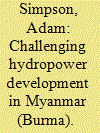

|
|
|
|
|
| Publication |
2013.
|
| Summary/Abstract |
Although general elections in Myanmar (Burma) in November 2010 have transformed the political landscape, many of the characters remain the same. While there is evidence of incremental domestic political openings many of the political constraints that existed during military rule remain in force. As a consequence of decades of military authoritarian governance and civil conflict, it is Myanmar's contested ethnic borderlands that have been the important locales for the development of environmental movements, despite increased recent domestic activity. This article analyses a case study of the largely cross-border campaign against hydropower dams on the Salween River in Myanmar and finds that through the suppression of opposition and dissent at home the regime has stimulated the creation of an 'activist diaspora', a dynamic transnational community of expatriates who engage in environmental activism beyond the reach of the regime. Due to their relative freedom on the border and in Thailand this community has developed expertise and international networks that have proved crucial in communicating the social and environmental impacts of hydropower development in Myanmar to the international community. Through increased cooperation with an expanding domestic civil society this established activist community is stimulating improved environmental governance of hydropower development and simultaneously assisting in the creation of a more open and democratic Myanmar.
|
|
|
|
|
|
|
|
|
|
|
|
|
|
|
|
| 3 |
ID:
178785


|
|
|
|
|
| Summary/Abstract |
This article examines building of the Seyhan Dam (1953–1956) in Turkey. Both Turkish and American agents played significant roles for planning and implementation of the project during the Cold War era. The 1950s provided necessary conditions in Turkey for the rise of new actors and developments to facilitate transition from limited modernity, which had mostly manifested in urban areas, to a more comprehensive state of modernity extended to rural areas. This extension had irrevocable impacts on the natural landscape as well. By referring to some patterns of modernization, this article posits building of the Seyhan Dam as a significant example to demonstrate how state-led modernization extended its scope by means of taming rivers and opening of plains for agriculture in the Cilician (Çukurova) region from late Ottoman to Republican periods.
|
|
|
|
|
|
|
|
|
|
|
|
|
|
|
|
| 4 |
ID:
094257
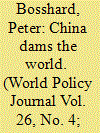

|
|
|
| 5 |
ID:
161448
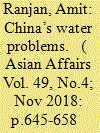

|
|
|
|
|
| Summary/Abstract |
This article looks at the problems facing China in regard of its water supply and usage. It considers China's available water resources and their uses, the growing water pollution, and the water management system adopted by China to secure the country's future. This includes small and large-scale projects, dams, the South-to-North Water Diversion Project/South-North Water Transfer Project (SNWDP/SNWTP) or Nanshuibeidiao, and the Sponge Cities Initiative. It also looks at some of the policy issues and relevant legislative frameworks developed to respond to the problem. This article argues that despite the measures taken by the Chinese government, water remains an area of concern for China.
|
|
|
|
|
|
|
|
|
|
|
|
|
|
|
|
| 6 |
ID:
083622


|
|
|
|
|
| Publication |
2008.
|
| Summary/Abstract |
Abstract: In 2001, two indigenous Orang Asli communities living in Peninsula Malaysia were forced to leave their homelands to make way for the Sungai Selangor dam. The dam, built to resolve water shortages in Kuala Lumpur, came with a comprehensive compensation package designed to alleviate the hardships faced by the displaced communities. This paper explores the discursive and material impacts of these compensation packages. We argue that the emerging literature on compensation for displaced people values the same sorts of economic and social criteria as the Malaysian government does in its pursuit of modernising the Orang Asli. Their shared belief that effective compensation would improve the quality of life for affected communities above pre-displacement levels helped to publicly legitimise the dam-building project. Interviews with the displaced communities, however, found stark differences in community satisfaction which have more to do with losses of intrinsic place-based cultural and spiritual values, for which there may be no effective or adequate compensation, than social and economic criteria. We conclude that compensation programmes will always struggle to effectively cope with these less tangible place-based values and that open acknowledgement of this weakness is required if alternatives to displacement-inducing development projects are to be more readily considered
|
|
|
|
|
|
|
|
|
|
|
|
|
|
|
|
| 7 |
ID:
084424


|
|
|
|
|
| Publication |
2008.
|
| Summary/Abstract |
Abstract: In 2001, two indigenous Orang Asli communities living in Peninsula Malaysia were forced to leave their homelands to make way for the Sungai Selangor dam. The dam, built to resolve water shortages in Kuala Lumpur, came with a comprehensive compensation package designed to alleviate the hardships faced by the displaced communities. This paper explores the discursive and material impacts of these compensation packages. We argue that the emerging literature on compensation for displaced people values the same sorts of economic and social criteria as the Malaysian government does in its pursuit of modernising the Orang Asli. Their shared belief that effective compensation would improve the quality of life for affected communities above pre-displacement levels helped to publicly legitimise the dam-building project. Interviews with the displaced communities, however, found stark differences in community satisfaction which have more to do with losses of intrinsic place-based cultural and spiritual values, for which there may be no effective or adequate compensation, than social and economic criteria. We conclude that compensation programmes will always struggle to effectively cope with these less tangible place-based values and that open acknowledgement of this weakness is required if alternatives to displacement-inducing development projects are to be more readily considered.
|
|
|
|
|
|
|
|
|
|
|
|
|
|
|
|
| 8 |
ID:
141916
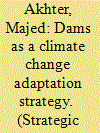

|
|
|
|
|
| Summary/Abstract |
Pakistani planners are increasingly prone to recognize the many links between water, food, and energy security. The construction of new large dams is seen by many as a concrete measure to achieve resource security for Pakistani for a future marked by climactic variability and unpredictability. This article explores the geopolitical and political geographic implications of Pakistan’s strategic vision of building dams as a way to prepare for climate change. The author argues that far from being politically neutral tools for development with predictable effects, large dams create new political and spatial arenas of conflict and contradiction at the international, regional, and local scales.
|
|
|
|
|
|
|
|
|
|
|
|
|
|
|
|
| 9 |
ID:
148813


|
|
|
|
|
| Summary/Abstract |
Iran has a long history of effective and sustainable water resource management under arid and semi-arid conditions. However, today the country is faced with serious challenges in the water sector, including rising water demand and shortages, declining groundwater levels, deteriorating water quality, and increasing threats to the environment and various ecosystems. If these issues persist, tragedy will be the inevitable result. Over the last three decades tremendous efforts have been made to supply water, primarily through an extensive program of development, with dam building at the forefront. This paper offers an introduction to the different factors and elements influencing the water balance in today’s Iran and presents a perspective on the trend of dam building in recent times.
|
|
|
|
|
|
|
|
|
|
|
|
|
|
|
|
| 10 |
ID:
188062


|
|
|
|
|
| Summary/Abstract |
Building on a global research sweep of terrorist organizations’ (as well as other non-state actors such as separatist and insurgent groups) use of fresh water as a target, weapon, or source of control, this paper analyzes attacks on major water projects (specifically dams and other related infrastructure) in South Asia—the region identified to have had the largest number of recorded water-related violent incidents. Focusing on India, Pakistan, and Afghanistan, and the post 9/11 period through 2019, the paper explores how large water infrastructures (and their environs) have become hot spots for violence between states that use water development projects to consolidate power, garner local loyalty, and create a national narrative and non-state actors who attempt to target these same projects to assert indigenous self-determination, subvert state power, or challenge state authority through terrorist means. Since fresh water is shared across borders, dam projects can become entangled in regional political disputes further exacerbating violent conflict between state and non-state actors. Given its impacts on water resources, climate change may act as a “threat multiplier” by enhancing local grievances, providing both government and terrorist groups additional incentives for exploitation, and further contributing to instability. The analysis provided here borrows from and contributes to the fields of development, environment and security, and terrorism studies.
|
|
|
|
|
|
|
|
|
|
|
|
|
|
|
|
| 11 |
ID:
119921
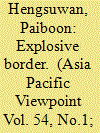

|
|
|
|
|
| Publication |
2013.
|
| Summary/Abstract |
The Salween borderlands can be conceptualised as spaces of exception where contradictory outcomes of state actions lead to state violence. The Burmese and Thai states have maintained their sovereign power and responded to economic regionalisation through violent practices in particular spaces. The political conflicts between the Burmese junta and ethnic minorities in the Salween borderlands have become war zones. The Burmese government in association with the Thai state and transnational dam investors has imposed the Salween dam projects on the Salween borderlands and people in the form of a terrorising state. The border people have experienced fear, danger and military violence, which has become part of the violence in everyday life. This paper provides an ethnographic study focused on specific events involving an explosion and death in a particular place and time on the Salween borderland. It shows the suffering of the border people in relation to sovereign power.
|
|
|
|
|
|
|
|
|
|
|
|
|
|
|
|
| 12 |
ID:
143895


|
|
|
|
|
| Summary/Abstract |
Good governance is an essentially contested concept. In Asian countries, economic efficiency and macro-economic projects have predominantly been pursued with the aim of promoting national, aggregate measurements of development. Hydroelectric power generation projects have played a central role in the national planning of several regional states as part of an attempt to achieve these goals. Even by their own terms of reference, however, hydroelectric power projects have at most a mixed record of success, and are increasingly criticized with regard to their negative impact on the environment, and upon vulnerable groups. The government of Malaysia has embraced the “developmental state” model, and this is best illustrated by governance initiatives and resource exploitation in the East Malaysian states of Sarawak and Sabah and their respective “development corridors”. Sarawak’s Corridor of Renewable Energy (SCORE) is the most visible sign of Malaysia’s macro-economic hydroelectric development focus, as Sabah’s corridor focuses on trade, investment, and tourism. This article takes a critical perspective towards good governance, emphasizing that it should function in the interests of all society, but in particular the most vulnerable. It therefore addresses the impact of Malaysian hydroelectric development policies on one of the most vulnerable sections of Malaysian society, the indigenous peoples of Sarawak. The findings cast doubt on the validity of continued prioritization of hydroelectric dam construction as a cornerstone of government energy and development policy.
|
|
|
|
|
|
|
|
|
|
|
|
|
|
|
|
| 13 |
ID:
126501
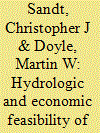

|
|
|
|
|
| Publication |
2013.
|
| Summary/Abstract |
The integration of hydropower facilities on existing low-head, non-Federal dams and their subsequent tie to regional electricity grids may serve as a useful de-centralized component of renewable energy integration in the United States. Thousands of low-head dams do not provide power and thus present few benefits with significant costs, including safety liability, fragmentation of river ecosystems, and persistent economic burden induced on state agencies due to regular inspection requirements. We conducted a feasibility study in the Piedmont region of North Carolina cataloguing over 1000 non-Federal dams with hydraulic head ranging from 4.6 m to 10.7 m (15 ft to 35 ft) and power capacity <300 kW ("micro" hydropower). Generation potential, greenhouse gas reductions, and financial viability were refined for 49 low-head dams over a 30-year life cycle using industry standard software (RETScreen4). Results suggest that most of these dams are not financially viable for energy production under cost structures evaluated at the time of this study. However, our results indicate that some low-head dams may be viable for energy production if provided funding opportunities comparable to the concurrent wind and solar markets.
|
|
|
|
|
|
|
|
|
|
|
|
|
|
|
|
| 14 |
ID:
099616
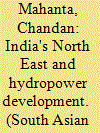

|
|
|
|
|
| Publication |
2010.
|
| Summary/Abstract |
Hydropower, while being projected as a clean and renewable energy source, has time and again been resisted vociferously in North East India in recent times because of the obvious and unintended social and environmental impacts. The anticipated negative impacts of the associated dam and reservoir construction have cast a threat to the security of the indigenous people in terms of water, food, livelihood, energy and above all, the related socio-economic concerns. This is all the more due to the uncertainties flowing from an inadequate understanding of the possible geo-environmental impacts in a highly sensitive terrain. To cope and live with the potential negative ramifications of hydropower projects, a comprehensive hydropower policy with emphasis on long-term environmental and social security and sustainability is imperative.
|
|
|
|
|
|
|
|
|
|
|
|
|
|
|
|
| 15 |
ID:
183933


|
|
|
|
|
| Summary/Abstract |
This paper studies the Korean War from an environmental perspective. The paper examines the political background that aggravated environmental damage and the ways in which hydro-warfare, ecological warfare, and epidemics are interconnected. By focusing on environmental destruction during the Korean War, this research questions the view of post-1950s industrialization and urbanization as the main sources of environmental crisis on the Korean Peninsula. The paper examines some of the major wartime disasters, such as the destruction of hydroelectric and irrigation dams and epidemic outbreaks. Special attention is given to the impact of aerial bombing, which not only resulted in the deaths of millions, but also created a chain effect of environmental destruction, population displacement, flooding, famine, and epidemic outbreaks. In revisiting them, it conclusively looks at the impact that military activities have on the environment and how the Korean War foreshadowed the rise of environmental warfare during the Cold War.
|
|
|
|
|
|
|
|
|
|
|
|
|
|
|
|
| 16 |
ID:
185233


|
|
|
|
|
| Summary/Abstract |
The contemporary US/Japan-Chinese rivalry and tension around dam building in the Mekong region is often mistakenly seen as the US and Japan’s reactive response to recently growing Chinese diplomatic and economic influence in the region. In fact, the United States and Japan have been critical architects of institutional and financial engineering for hydropower development in the Mekong region, which predates involvement by the People’s Republic of China (PRC). The factors and dynamics involved in significant lending regime shifts away from a liberal hydropower finance regime to an export credit driven model premised on Asian economic statecraft is an understudied topic. This article fills part of this gap through a case study of evolving hydro-financing regimes in Lao PDR from the 1970s to the present. The study draws on extensive ethnographic work in Laos, Japan, Thailand, and the United States with local and external political elites, hydro-financing technocrats, and business actors and gains additional insights from analysis of primary firm, institutional, and government documents. The article finds that the role of economic crises and their impact on the relative economic power of hydropower financing regimes as well as their ideational impact on borrower regimes are significant in explaining shifting patterns in lending regime dominance.
|
|
|
|
|
|
|
|
|
|
|
|
|
|
|
|
| 17 |
ID:
107546
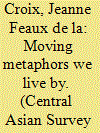

|
|
|
|
|
| Publication |
2011.
|
| Summary/Abstract |
Based on anthropological fieldwork between 2006 and 2008, this article compares how people in the Toktogul region of Kyrgyzstan understand and interact with water in three highly significant places: mountain pastures (jailoos), the Toktogul hydroelectric dam that controls the flow of the Naryn and sacred sites (mazars). Sidelining the vast standing waters of Toktogul Reservoir, valley residents instead highlight the positive qualities of flowing water at mazars, pastures and the working dam. Contrasting how metaphors of running water are put to use conceptually by Toktogul residents and social scientists opens up a critique of current academic and policy-oriented descriptions of the world as 'flow'. Attention to a particular kind of movement (flowing water) highlights some of the silent assumptions in current depictions of a mobile world 'in flux'.
|
|
|
|
|
|
|
|
|
|
|
|
|
|
|
|
| 18 |
ID:
092255


|
|
|
|
|
| Publication |
2009.
|
| Summary/Abstract |
Public financial institutions (PFIs) provide vital investment for poor countries, and act as catalysts for additional private capital. However, the projects thus financed often have social and environmental side effects. Safeguards systems control such side effects. This article compares the strength of PFIs' safeguards systems. Although the study uses financing for dams as an example, the issue has much larger applicability. In fact, all development project or policy interventions have social or environmental side effects and therefore necessitate safeguards. This article notably finds substantive evidence that safeguards performance substantially differs between different PFIs. It argues that the most important explanations for this finding are differences in coordination mechanisms among different PFIs, and diverging interest group pressure on different PFIs. Finally, the article explores several avenues for future work following from these findings, notably exploring steps to harmonize PFIs' safeguards performance.
|
|
|
|
|
|
|
|
|
|
|
|
|
|
|
|
| 19 |
ID:
106541


|
|
|
|
|
| Publication |
2011.
|
| Summary/Abstract |
The construction of large dams continues apace in many developing countries. This is no more evident than in China, where half of the world's large dams are now located. A decade ago the World Commission on Dams released its review of large dams around the world. The report provided a framework for the decision-making of governments, donors, policymakers, planners, and dam builders across seven strategic priorities: to gain acceptance; assess options; address existing dams; sustain rivers and livelihoods; recognize entitlements and secure benefits; ensure compliance; and share rivers across boundaries. Using the strategic priorities as a frame for analysis, this article reviews the progress made by the Chinese government over the last 10 years with respect to addressing the human casualties of large dam construction. It identifies specific frailties and strengths in Chinese policy and practice. It suggests that a stakeholder satisfaction model that places the affected population at the centre of the accountability structure would ensure that those who are tasked with the administration of resettlement policies are answerable to the affected people. In this way, resettlement from large dams can become truly people-centred.
|
|
|
|
|
|
|
|
|
|
|
|
|
|
|
|
|
|
|
|
|